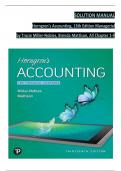Exam (elaborations)
Solution Manual for Horngren's Accounting, The Managerial Chapters, 13th Edition By Tracie Miller-Nobles, Brenda Mattison, Verified Chapters 1 - 9, Complete Newest Version
Solution Manual for Horngren's Accounting, The Managerial Chapters, 13th Edition By Tracie Miller-Nobles, Brenda Mattison, Verified Chapters 1 - 9, Complete Newest Version Solution Manual for Horngren's Accounting, The Managerial Chapters, 13th Edition By Tracie Miller-Nobles Brenda Mattison, Verif...
[Show more]



